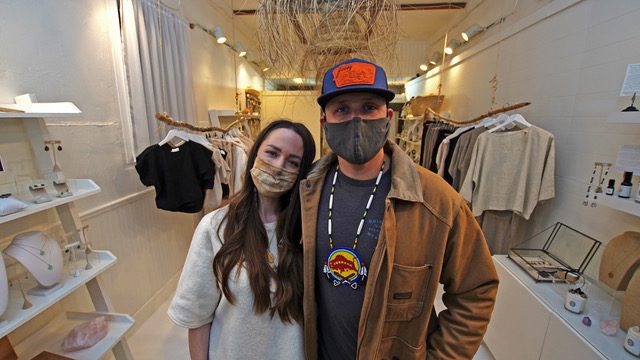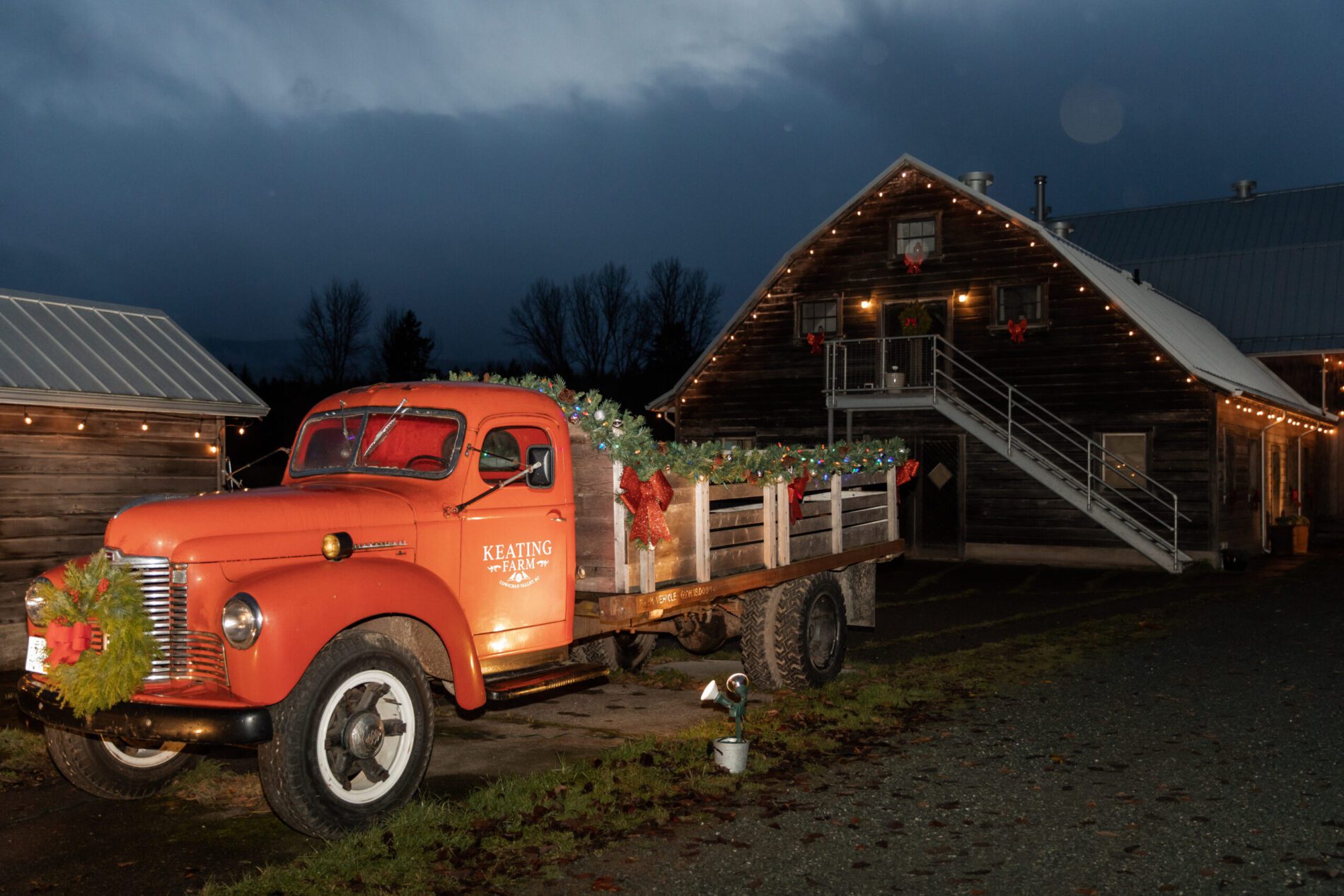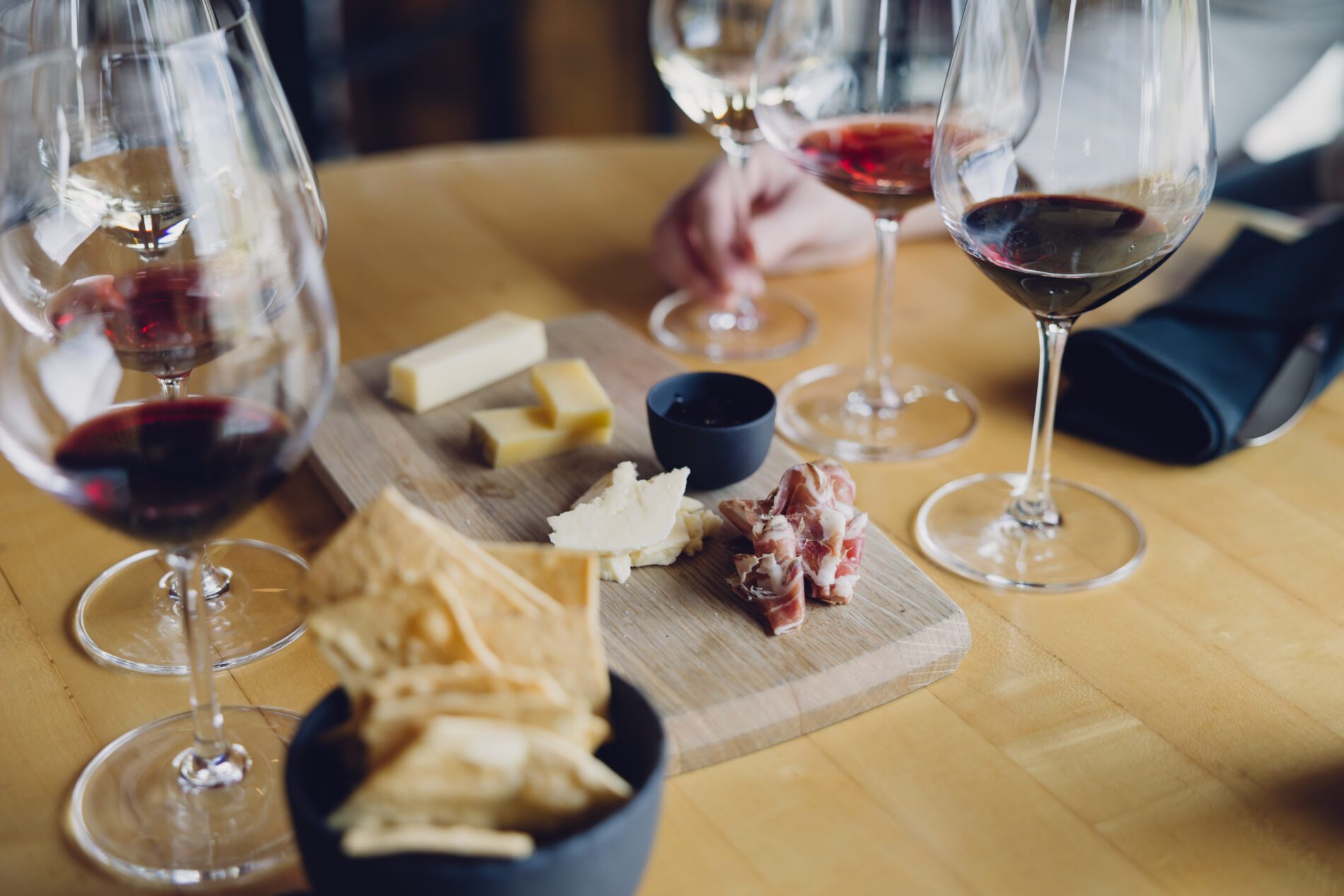Cowichan Bay a picturesque part of the Island that brings together the natural environment, modern industry and thousands of years of cultural history. Claire and Lawrence Crowfoot have been doing business in Cowichan Bay for almost a decade.
Their store ‘Crowfoot Collective‘ is nestled in the heart of Cowichan Bay among the many brightly coloured shops. Just a step off the main road is a hobbit-like door that brings shoppers through to the Collective. The shop is full of handmade and ethically sourced products like jewellery, clothing, candles, and scents. Indigenously-owned, the Collective not only showcases Indigenous artists, BIPOC (Black, Indigenous, Person of Colour) artists and women-led businesses, they also provide a welcoming space for people to learn about the people behind each product.
But beyond the high-quality and authentic items, there’s love here. For Claire and Lawrence, the business is a family affair; they design the jewellery together, work on their garden together, learn about each artisan they bring in the shop together. All the while, they are consulting with their 4-year old son Billy on all the important matters.
Here is Tourism Cowichan Question and Answer with Claire and Lawrence Crowfoot about their shop and their community.
Can you briefly describe Crowfoot Collective?
Lawrence: The Crowfoot Collective is a collection of Indigenous artists, locally, as well as in Alberta — my home reserve is Siksika. We like to focus on Indigenous art and local handmade goods. Everything we carry is handmade, everything we create serves a purpose, and there’s not one thing in the store that we wouldn’t wear, burn in our house, like candles, or put on our own skin. Everything we do is like 100% a reflection of us, this whole store.
What made you want to open the shop in Cowichan Bay?
Claire: We love Cowichan Bay. We’ve been living in the Bay for about 10 years. It’s such a beautiful spot. It’s really quaint, it’s really eclectic. We love that we get a lot of tourists from all over the world, obviously not right now. It’s just beautiful. The mountain just has such a presence. We love it here.
Lawrence: We have the ocean, and a couple times a year, you might be lucky enough to see orcas go through. So it’s just a beautiful place, you’ve got all sorts of people coming in from all over the island. It’s kind of a little bit of a hub, like a little place to take a break and then carry on through. We just try to provide a nice experience to those people. As well as an experience for the locals to come too and buy quality goods.
Can you describe your jewelry line?
Claire: We really focus on the gemstones when we create the jewelry. We centre the gemstones, and then we kind of design around them — because we believe in the healing and the spiritual properties of the gemstones themselves.
And then for our upcoming collection, we’re really excited about this one. It is the first one that Lawrence has designed. And this one has a lot of his Blackfoot heritage that he is drawing from, so there’s a big Indigenous component to this jewelry line. Also, there’s a lot of celestial in this line — honouring the moon and the sun and the stars, which is really cool. And even Billy had input in this one. We ask him about everything.
Lawrence: Yeah, for sure, the whole family gets in on it, in on the design part of it. We just kind of go from there. He’s the final say.
What makes your apothecary line special?
Lawrence: The apothecary line is essentially based off of things we’ve been growing in our garden and that we’ve harvested from Siksika as well.
Claire: Yeah, we brought back a lot of plants that we grow in our garden, and Billy again is heavily involved. He’s really into gardening and he has his own medicine garden. We grow tobacco, sweetgrass, sage, rose, lavender, mint, lots of things. We use them in the candles, the mists, and we just started a line of oil-based perfume.
What kind of artisans do you carry in your shop?
Claire: We mainly focus on handmade, fair-trade and ethical, so all our artisans are paid fairly. We really do a lot of research before we bring anyone into the shop and we make sure that they align with what we believe in as well. We have a lot of women-lead business, indigenous-lead business and BIPOC businesses. We have a lot of beautiful local artisans.
We think it’s really important that you can buy something feeling good knowing that you are helping to support that person’s livelihood that they’re making a good wage, they’re supporting their family from these purchases. So, if you purchase something authentic, you are actively keeping that alive, which is really important.
How does education factor into your business?
Lawrence: So education basically starts right at the beginning. Whenever we’re researching a new designer that we want to bring into the shop, Claire and I are always educating ourselves on that designer, their culture, how they’re going to fit within our shop. We take that knowledge, and then we pass that forward to the person coming to buy it.
Claire: I think it’s important for people to know who they’re buying from and the story behind what they’re buying and who they’re supporting, where it comes from, where it’s made. We have had people come in and say, if they’re not Indigenous, ‘I don’t think I can wear beadwork because I’m not Indigenous.’ That’s just a misconception. As long as you’re buying beadwork or art that is created by an Indigenous person to sell, then it’s actually supporting it’s not misappropriation at all. Buy it! You’re helping that Indigenous person who has created that to sell. It’s meant to be worn and enjoyed.
Why do you think it’s important, as a business owner, to be part of the community?
Claire: I think that community is everything, really. We have a beautiful community here in Cowichan Bay that we rely on a lot. We’re pretty far away from Lawrence’s Reserve and Billy’s Reserve, but we still want him to grow up within an Indigenous community. We’re lucky enough to have beautiful Indigenous communities surrounding us in Victoria and in Cowichan Tribes.
Lawrence: It goes back to the redistribution of wealth. When you’re tied into the community, it’s like you feel like you need to do everything you can to uplift the more vulnerable or, the less fortunate. You know there’s a lot of people within the Cowichan area who don’t know a lot about the community that surrounds them — so it’s important that you know the community you live in.
How does sustainability factor into the artists you choose?
Lawrence: Everything is made in small batches, like our candles and our apothecary line. You know we’re not mass producing this by any means. It’s just the two of us, so there’s no assembly line going on.
Claire: We do choose artisans based on sustainability and sustainable practices. Obviously, handmade is really sustainable because you can only make so many. We work with some incredible seamstresses, and if you get a hole or a tear in your clothes, they will repair it for you. There are pieces that will last forever, they’ll last for years and years, and they’re meant to be repaired. They’re not really trendy, like fast fashion is. We just bring in really classic pieces that you can have for your whole life.
Having you been doing anything differently to weather the Covid storm?
Claire: Yeah, we have focused on online sales like a lot of companies have. We had a website for a few years, but it was just like an added bonus, but now we’re really centering our focus on our website, and we’ve noticed that we do sell a lot more online. We can offer free local pickup, which is nice. We really shifted our focus to online, as many have.Lawrence: Honestly, when you’re buying a candle online, you can’t smell it, touch it, you can’t look at it. So I think we’ve done a really good job of putting that in words. You’ll have a pretty good idea. We’re just trying to fill that gap to allow somebody who may be immune-compromised who can’t come into the shop to have that experience as best they can on the website.
Meg Cuthbert



